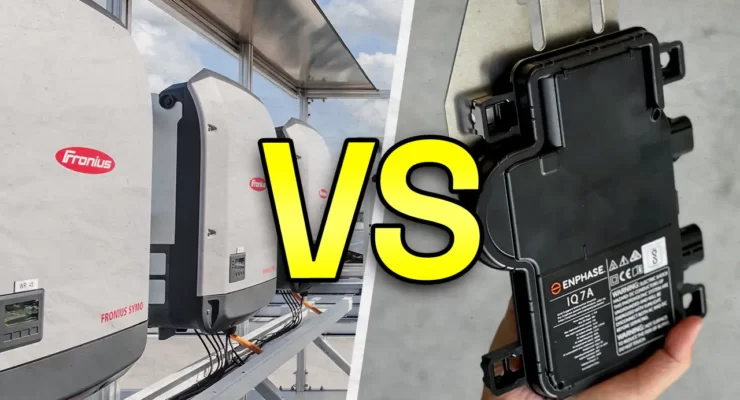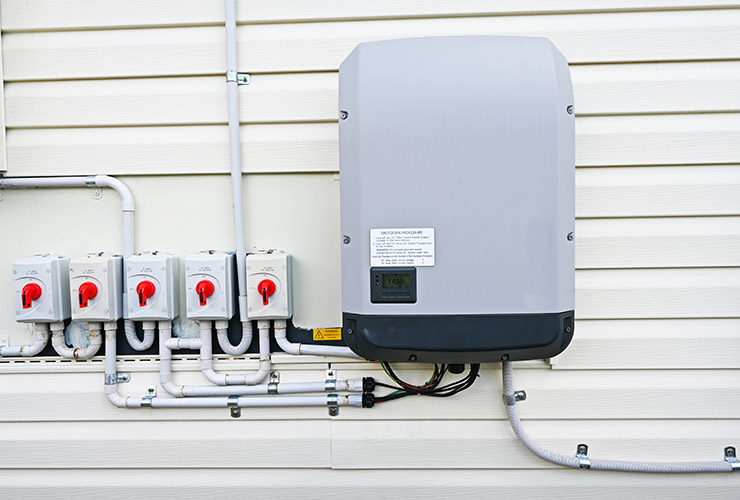
Fast read
Microinverters and string inverters are two different types of inverters used in photovoltaic (PV) systems to convert direct current (DC) electricity from solar panels into alternating current (AC) electricity that can be used in homes and businesses.
Microinverters are attached to individual solar panels or pairs of panels and operate independently to convert DC power to AC power almost instantly. String inverters, however, are larger and operate by converting the combined DC electricity from all the panels in a PV system to AC electricity.
Some advantages of microinverters include; better performance of individual panels, safer AC electricity on the roof, excellent monitoring of each panel, easy expansion of the system, and rapid shutdown capabilities.
When should I go for a Microinverter vs a String inverter?
With the wide range of brands and inverter solutions, it is sometimes difficult to determine the best solution. Let me say first that there are solar system owners with string inverters and microinverters who are extremely satisfied with their solar power system’s performance. Therefore this is not an either-or question so when we say microinverter vs string inverter, remember it is dependant on your particular situation,
What is a microinverter, and why go for it?
Microinverters are a smaller type of inverter that you can attach to singular solar panels or a pair of panels.
They sit in the array area, on the roof, behind the railing of the panel. Microinverters can operate independently to convert DC power to AC power almost instantly. The key brand for this technology in Australia and NZ is a manufacturer called Enphase. They are known for their high reliability.
A significant disparity exists between string inverters and microinverters. Standard string inverters will limit the electricity produced by each panel to the lowest-producing one on your roof. Microinverters have no such problem because they work independently in parallel circuits.
Standard string inverters can also be fitted with power optimisers. These are similar to microinverters, but the electricity is not converted to AC behind each panel. Instead, the string inverter still does the work. Optimisers, such as from the Tigo brand, can smoothen voltage and reduce production differences.
This allows for increased solar power output even in partially-shaded installations. The microinverter will maximise the potential of each panel‘s production. Each panel will convert its power to the grid voltage individually.
Advantages of Microinverters
1. Each panel performs to its best
As microinverters are attached to each panel, they ensure each panel performs to its highest potential. This means one panel performing at a lower level does not affect the performance of the entire solar array. For example, if one panel in a row is affected by shading with a string inverter, the whole string will be affected, and the PV output will be reduced. However, a microinverter treats each panel individually; therefore, such a handicap does not apply.
2. AC electricity on the roof can be safer
Solar panels produce DC electricity and, in a connected string, can have a high DC voltage of 600 and even 1000V in commercial systems. Such a high DC voltage on your roof can lead to sparking and can be dangerous if poorly installed. Microinverters immediately convert DC electricity at the panel level to the standard 240V AC electricity. While still presenting risks, traditional AC electricity is considered safer than DC.
3. Excellent monitoring of each panel
If you have one dud panel in a string, this dud will pull down the performance of the whole string in a string inverter solution. In a microinverter solution, you will see the lower performance of this one panel in the individual panel level monitoring and then take some action.
4. A solution for difficult installation conditions
Microinverters can be used if one faces a problematic roof with multiple angles. This means that some panels face south, east, and west. Microinverters are also recommended if there are shading issues because of trees or large chimneys.
These situations will produce different amounts of solar power at different times. Microinverters, however, will allow you to harvest all the energy. On the other hand, standard inverters will lose some output in such installation situations.
5. Easy system expansion
Microinverters can be easily added to your solar PV system to expand them. Even if panel models have changed, you can easily add each new panel and microinverter pair to your existing solar array.
6. Rapid capability
New electrical codes require rapid shutdown of the solar system to ensure that firefighters and first responders are protected from high voltages when working in hazardous situations. These microinverters meet the requirements for rapid shutdown and are embedded in each inverter

Disadvantages of Microinverters
1. Cost
One disadvantage is that microinverters are more expensive than central string inverters. On average, microinverters cost much more, if calculated per watt, than a string inverter. However, this cost can be justified when considering the performance benefits and more extended warranties you get from microinverters.
2. Mismatch of panel wattage and microinverter capacity
Panel wattage has raced away in the past years, from 300 watts per panel in 2017 to over 400 Watts now. In some cases, a microinverter with a capacity slightly above 300W gets paired with a 400W panel, creating what’s known as a mismatch.
As a result, some electricity is lost. Luckily, the worst time of the day for this situation to occur is usually only a short period around lunchtime, when your panel production is the highest. The loss in such an instance is known as clipping.
3. Replacements and repairs take place on the roof
String inverters typically have easy access on the side of the house or in a garage. However, if a microinverter needs replacement, the solar installer must get on the roof to swap the unit. Sometimes, the frame bolts might have seized after a few years, especially near the coast, and changing the microinverter can take some time.
What is a string inverter?
A string inverter works in a series circuit. Usually, 6-12 individual solar panels are within ‘series strings’. In many residential systems, two strings come from the roof.
The string inverter is often installed near an electricity meter or switchboard. Common brands are Fronius, SMA, Sungrow, Firmer, and Growatt.
String inverters convert the energy generated by these panels from DC to AC, not on the roof but on the side of the house. The quality brands are long-lasting, and it’s a tested reliable technology.
Advantages of String inverters
1. Cost
Compared to microinverters, a string inverter is often cheaper than a microinverter set.
2. Environmental analytics
The more advanced string inverters can come with a power control interface with added functions. One of these additional functions is environmental information. For example, your string inverter can give you information on ambient temperature, wind speed, and irradiation factors.
With this information, you can find patterns of when your solar energy system has a higher and lower output and adjust your electricity consumption patterns accordingly. This information may also highlight issues with your panels, so you can act quickly to find the solution.
3. Ease of installation
When installing string inverters, the panels are connected in a string. Many roof systems consist of two lines. A relatively fast and efficient way, as only the string cables need to be channelled to the inverter and plugged in.
This makes the installation process much easier and faster. Firstly, installation costs are lower because of reduced labour. Secondly, there’s a reduced chance of flaws during system installation. Finally, there are fewer cables to manage, meaning fewer cables that can be wrong or damaged, meaning a simple, robust system.
4. Easy to fix problems with them
Opting for a string inverter vs microinverter for your solar panel offers the benefit of requiring only one to convert Direct Current (DC) electricity from PV panels to Alternating Current (AC) electricity. As a result, troubleshooting becomes relatively easy if issues arise within your solar array, given the installation of this single inverter.

Disadvantages of String inverters
1. System Expansion
To add more panels to your current solar system, string inverters introduce some complexity to the process. Expanding with string inverters demands additional wiring to all panels. This means either adding a separate string inverter or completely redesigning the previous cable run.
Also, the inverter has to have the ability to take extra panels, and the design and safety rules can not change significantly since the original installation time frame.
2. Limitation of output
As previously mentioned, string inverters ensure all the panels perform equally to the weakest panel. This can limit the output of your solar array, limiting the amount of electricity you receive in your home.
For example, if nine of your panels are performing at 95%, and the tenth panel is in the shade and performing at 50%, all of your panels in that string would perform at 50%. For the period that panel 10 is in the shade. This means you would lose a lot of electricity output because of this technical characteristic.
3. They are only as strong as their weakest link
String inverters require that solar panels be wired in series. The solar array will only be as strong as its weakest panel. The whole string output is concerned if a portion of a solar panel’s production is affected.
4. Shorter lifespan
Microinverters commonly offer warranties lasting 25 years, whereas string inverters typically last between 8 to 12 years.
5. Complexities of solar system expansion
A string inverter should operate at its maximum capacity to get the best performance. To expand your solar array, the panels must be routed to another string inverter. This will add labour and costs when you seek to expand your solar panel system.
6. Monitoring system
Although aggregate solar energy production can be seen, it is impossible to see individual panels’ performance issues. This could be because of cracks, defects, or delamination. Therefore, a string inverter system, without separate optimisers on each panel does not allow for panel-level monitoring.
As you research your solar and battery options and speak to installers, I am sure you will see how passionate many feel about this subject. We have listed many of the advantages and disadvantages and why the question microinverter vs string inverter is so popular.